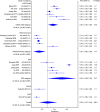The prevalence of depression in axial spondyloarthritis and its association with disease activity: a systematic review and meta-analysis
- PMID: 29996916
- PMCID: PMC6042424
- DOI: 10.1186/s13075-018-1644-6
The prevalence of depression in axial spondyloarthritis and its association with disease activity: a systematic review and meta-analysis
Abstract
Background: Depression is common among patients with axial spondyloarthritis (axSpA), but reports of its prevalence are highly variable. We performed a systematic review to (i) describe the prevalence of depression in axSpA, (ii) compare its prevalence between axSpA, ankylosing spondylitis (AS) and non-radiographic axSpA (nr-axSpA) cohorts, and (iii) compare disease activity and functional impairment between those with and without depression.
Methods: We searched Medline, PubMed, Web of Science, PsycINFO, CINAHL Plus, the Cochrane library and conference abstracts of the European League Against Rheumatism, British Society for Rheumatology and American College of Rheumatology using a predefined protocol in accordance with Preferred Reporting Items for Systematic reviews and Meta-Analyses (PRISMA) guidelines. Meta-analysis was performed using quality-effects model.
Results: Fifteen original articles and one abstract were included for analysis; 14 studies described AS cohorts and two nr-axSpA. Three screening criteria and one diagnostic criterion were used to define depression. Prevalence ranged from 11 to 64% depending on criteria and thresholds used. Pooled prevalence of at least moderate depression was 15% using the Hospital Anxiety and Depression Scale (HADS) threshold of ≥ 11. The prevalence of depression was similar between axSpA, AS and nr-axSpA cohorts. Patients with depression had significantly worse disease activity, including higher BASDAI by 1.4 units (95% CI 1.0 to 1.9), ASDAS by 0.5 units (95% CI 0.3 to 0.7) and ESR by 3.5 mm/h (95% CI 0.6 to 6.4). They also had greater functional impairment with higher BASFI and BASMI by 1.2 units (95% CI 0.6 to 1.8) and 0.6 units (95% CI 0.3 to 0.8), respectively. Mean age of each study cohort inversely correlated with depression prevalence.
Conclusions: Depression is common among axSpA patients and is associated with more severe disease activity and functional impairment. Identifying and managing depression should form part of their holistic care. Further longitudinal studies are needed to explore the impact of depression on treatment outcomes and axSpA treatment on symptoms of depression.
Keywords: Ankylosing spondylitis; Axial spondyloarthritis; Comorbidity; Depression; Disease activity; Functional impairment; Mental health; Meta-analysis; Prevalence.
Conflict of interest statement
Ethics approval and consent to participate
Not applicable.
Consent for publication
Not applicable.
Competing interests
The authors declare that they have no competing interests.
Publisher’s Note
Springer Nature remains neutral with regard to jurisdictional claims in published maps and institutional affiliations.
Figures
Similar articles
-
Prevalence of peripheral and extra-articular disease in ankylosing spondylitis versus non-radiographic axial spondyloarthritis: a meta-analysis.Arthritis Res Ther. 2016 Sep 1;18(1):196. doi: 10.1186/s13075-016-1093-z. Arthritis Res Ther. 2016. PMID: 27586785 Free PMC article.
-
Relationship between psychiatric status, self-reported outcome measures, and clinical parameters in axial spondyloarthritis.Medicine (Baltimore). 2014 Dec;93(29):e337. doi: 10.1097/MD.0000000000000337. Medicine (Baltimore). 2014. PMID: 25546683 Free PMC article.
-
Prevalence and impact of comorbidities in axial spondyloarthritis: systematic review and meta-analysis.Rheumatology (Oxford). 2020 Oct 1;59(Suppl4):iv47-iv57. doi: 10.1093/rheumatology/keaa246. Rheumatology (Oxford). 2020. PMID: 33053193 Free PMC article.
-
Clinical improvement and reduction in serum calprotectin levels after an intensive exercise programme for patients with ankylosing spondylitis and non-radiographic axial spondyloarthritis.Arthritis Res Ther. 2016 Nov 25;18(1):275. doi: 10.1186/s13075-016-1180-1. Arthritis Res Ther. 2016. PMID: 27887637 Free PMC article. Clinical Trial.
-
Characteristics and burden of disease in patients with radiographic and non-radiographic axial Spondyloarthritis: a comparison by systematic literature review and meta-analysis.RMD Open. 2019 Nov 21;5(2):e001108. doi: 10.1136/rmdopen-2019-001108. eCollection 2019. RMD Open. 2019. PMID: 31803500 Free PMC article.
Cited by
-
Prevalence of depression in SARS-CoV-2 infected patients: An umbrella review of meta-analyses.Gen Hosp Psychiatry. 2023 Jan-Feb;80:17-25. doi: 10.1016/j.genhosppsych.2022.12.002. Epub 2022 Dec 7. Gen Hosp Psychiatry. 2023. PMID: 36535239 Free PMC article.
-
Impact of gastrointestinal and psychological symptoms on disease activity and functional impairment in patients with spondyloarthritis: a cross-sectional study.BMC Rheumatol. 2025 Mar 6;9(1):28. doi: 10.1186/s41927-025-00478-y. BMC Rheumatol. 2025. PMID: 40050979 Free PMC article.
-
Systematic review of mental health comorbidities in psoriatic arthritis.Clin Rheumatol. 2020 Jan;39(1):217-225. doi: 10.1007/s10067-019-04734-8. Epub 2019 Sep 5. Clin Rheumatol. 2020. PMID: 31486931
-
The effects of WeChat-based educational intervention in patients with ankylosing spondylitis: a randomized controlled trail.Arthritis Res Ther. 2021 Mar 4;23(1):72. doi: 10.1186/s13075-021-02453-7. Arthritis Res Ther. 2021. PMID: 33663558 Free PMC article. Clinical Trial.
-
Effect of group-based physiotherapy on pain and depression in patients with axial spondyloarthritis and non-specific low back pain: data of 1-year follow-up.RMD Open. 2023 May;9(2):e003001. doi: 10.1136/rmdopen-2023-003001. RMD Open. 2023. PMID: 37137542 Free PMC article. No abstract available.
References
-
- Rudwaleit M, Jurik AG, Hermann KG, Landewe R, van der Heijde D, Baraliakos X, et al. Defining active sacroiliitis on magnetic resonance imaging (MRI) for classification of axial spondyloarthritis: a consensual approach by the ASAS/OMERACT MRI group. Ann Rheum Dis. 2009;68(10):1520–1527. doi: 10.1136/ard.2009.110767. - DOI - PubMed
Publication types
MeSH terms
LinkOut - more resources
Full Text Sources
Other Literature Sources
Medical
Research Materials
Miscellaneous



